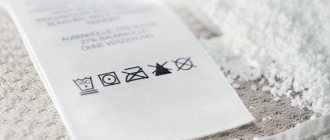Tulle is a thin translucent fabric. It diffuses the sun's rays, transforming the room and decorating the window. Compared to practical blinds, tulle curtains give the space a cozy and airy charm. Settling dust and bright sun over time spoil the appearance of the material, many everyday questions arise: how to wash tulle in an automatic washing machine, or maybe better by hand?
How to wash tulle to give it pearly whiteness or maintain its color? And if yellowness, grayness or greasy stains appear on the fabric, what should you do? Knowing the basic secrets and rules of washing, you can easily restore its original appearance. In this article you will find many practical and accessible tips for care and washing.
Determining the fabric
First of all, before washing, you need to understand what fabric the curtain is made of. Fabrics from which tulle is made:
- silk;
- viscose;
- polyester;
- nylon;
- cotton.
Modern fabrics can consist of several types of threads, for example with the addition of bamboo or wool. Knowing the composition, you can accurately choose the simplest and most effective method of care.
Polyester and nylon are the strongest fabrics, their shelf life is more than ten years, they are strong and durable. When washing all artificial fabrics, first of all, you need to monitor the temperature, otherwise they may turn yellow.
Tulle made from cotton, silk or natural threads is very beautiful, but requires delicate handling. You can wash this curtain by hand or using the delicate cycle in the washing machine.
Temperature
At what temperature to wash tulle depends on the composition and structure of the fabric.
- The most unpretentious curtains are made of polyester and nylon - they can easily withstand temperatures of 40-60 degrees;
- Organza, veil or muslin are very sensitive to high temperatures, so the water should be no more than 30 degrees;
- Materials made from several types of fabrics, but based on natural fibers, such as cotton, can be washed at 60 degrees. High temperature bleaches tulle made from natural fabrics well and easily removes dirt, without additional products.
Remember that when choosing a temperature regime, it is important to follow the manufacturers' recommendations for a particular type of fabric.
Next you will learn about the nuances of each type of washing.
Ways to clean curtains without removing them
If the curtains are not too dirty, then they can be cleaned of dust without washing, without removing them from the curtain rod. There are several different ways you can freshen up a curtain.
Dry cleaning
Dry cleaning is done using a vacuum cleaner with a special attachment. This method is mainly suitable for tapestry, but other types of fabric can be cleaned in this way. The main thing is not to spoil the delicate texture of the material with a brush.
Often, cleaning with a vacuum cleaner is aimed at the upper part of the curtains, where a large mass of dust accumulates and where it is difficult to reach with a regular rag.
Wet cleaning and steaming
Wet cleaning is carried out using a soap solution and a sponge. This cleaning is suitable for roller curtains. Steaming is performed either with a steam generator or with an iron that has a vertical steam supply function. During exposure to steam, the curtain is not only smoothed out, but also disinfected and refreshed.
Steaming is best done on material that is not afraid of moisture and does not shrink when the temperature increases. However, if the curtain is very dirty, then this method of cleaning the product will not work.
General washing secrets
How to wash tulle correctly? Check out the practical recommendations for any materials:
- Shake and remove dust before washing;
- It is not recommended to use chlorine-containing bleaches, they seriously damage the fabric;
- the water temperature should be no more than 40 degrees, otherwise the fabric will “shrink”;
- first dilute the dry powder in a small amount of warm water or use liquid products;
- dry the fabric in a straightened form; do not squeeze it too much or twist it at high speeds.
- You should not completely dry the tulle; it is better to hang it wet on the windows, and you can smooth out the folds with your hands.
Now check out the machine wash recommendations.
Useful tips
General washing tips that will help maintain the original whiteness of tulle for a long time:
- before soaking, shake the tulle to remove dust;
- do not use chlorine-containing bleaches, which leads to rapid wear of the material;
- after washing, do not twist the product, but allow the water to drain naturally;
- The optimal temperature limit when washing light tulle is 35-40 ᵒC, otherwise it will shrink.
You will find maximum useful information about washing clothes and various fabric products here.
Machine washable
For owners of advanced modern washing machines, it is enough to turn on the special “for curtains”, “delicate” or “silk” mode and any curtain will be washed carefully.
How to properly wash tulle in a washing machine? For regular automatic models, use the “hand wash” mode at a temperature of 30 degrees. There are several recommendations for proper machine washing:
By the way, the “wool” mode is great for curtains and tulle, so you can wash and preserve the fabric as carefully as possible.
- How to wash tulle from grayness? Pre-soak it for several hours or overnight in water, adding salt (1 tbsp) and powder;
Salted water is also perfect for colored fabrics, this will make the curtains brighter.
- Fold the tulle fabric inside the drum neatly and evenly, no need to crumple it, so the number of folds will be minimal. It is best to place the tulle in a special case to preserve the integrity of the fabric and protect it from accidental damage in the drum;
- Wring out the washed item at very low speeds (400-500), otherwise the curtain may turn into a crumpled lump;
- Choose the temperature depending on the composition of the material, but not higher than 40 degrees;
- Replace the dry powder with liquid gel or shampoo, add a very small amount, half the usual volume. For curtains, foaming should be as low as possible.
When the tulle wash is complete, you can turn on the extra rinse cycle to thoroughly remove the detergent.
Basic recommendations
Snow-white curtains can transform not only windows, but also the entire interior of a living space. This requires regular washing of tulle - at least 4 times a year. This will get rid of dust, prevent deep accumulation of dirt, and discoloration to yellow or gray.
This is especially true for curtains that are placed in the kitchen area. These tulle curtains cannot be cleaned with simple ingredients: warm water and detergent. In this situation, the housewife will need bleaching or chemical-containing products.
To avoid such negative consequences, we recommend that you remember how to wash tulle correctly:
- Before soaking the textile product, it is necessary to remove dust. Housewives can shake it several times on their own balcony or when going outside. This will prevent the accumulation of dirt particles during the washing process;
- Avoid bleach that contains chlorine. He is able to return the white tone of tulle in a matter of minutes, but thin fabrics wear out faster;
- do not twist the tulle curtains. Allow some time for the water to drain naturally. If the housewife wants to speed up drying, it is recommended to gently wring out the curtains;
- wash the tulle at the optimal temperature. Airy fabric washes well at 35-40, and polyester - no higher than 60 degrees Celsius. Increasing the threshold will cause the tulle to “shrink”, and cool water is simply not able to cope with deeper dirt;
- It is not enough just to wash the curtain. In order for it to be snow-white, it is important to adhere to proper drying. High temperatures cause a yellow tint to appear on white textiles. Therefore, it is forbidden to smooth out folds with an iron; the optimal solution is to hang wet tulle on the curtain rod. Under its own weight, the fabric will smooth out and dry in a short period of time.
It is extremely difficult to get the correct water temperature when washing by hand. It is possible to use a special water thermometer or rely on your own feelings. The palm and fingers are not able to accurately indicate the temperature, but the skin on the elbow has the necessary sensitivity. If the “test” with your elbow brings you a comfortable feeling, you can wash it. Otherwise, we recommend adjusting the temperature.
Handwash
Many housewives wash tulle by hand, so the stains are better visible and the possibility of damaging the fabric is minimal. In addition to using regular powders, you can use natural products with the addition of bleaches.
How to wash tulle to make it white at home? Below we will look at effective, folk secrets of washing without resorting to chemicals.
By the way , if you don’t have a thermometer, and for washing you need to make the water 30-40 degrees, use your elbow as a hint. Touch the water with your elbow and feel it, it should be pleasant. If it feels cold or hot, adjust it to a comfortable state. This folk method has also been used for a very long time and has been successfully used by parents before bathing small children; they also require a temperature of no more than 40 degrees.
All the subtleties of ironing
Does tulle need to be ironed? Typically, synthetics straighten out on their own during drying. But if there is an ornament on it, and it has become deformed after washing, it is worth ironing the curtains while they are still damp. We do this exclusively through fabric (gauze). Using light sliding movements, set the iron to 110 degrees.
Expert advice
Natalia Prokofieva
Expert in the field of washing, cleaning, stain removal on various materials and surfaces
Ask a Question
You can also iron it with your hands. How to do it? We hang the tulle. We wet a small area of the curtains with water, you can spray it with a spray bottle. And then we simply iron the curtain on one side and the other with our hands.
Complex contaminants
What is the best way to wash tulle and very dirty curtains, especially kitchen curtains, because they absorb not only dust and odors, but also soot? There is a huge variety of methods; we will look at the simplest and most effective ones.
- If there are individual grease stains on the tulle, to remove them, sprinkle this area generously with starch before washing.
First of all, to make the tulle white, try soaking it in warm water with the addition of soda and salt for several hours or overnight.
Video on the topic:
How to wash tulle in an automatic machine so it doesn’t wrinkle
There are special laundry bags for this: you just need to fold your tulle and place it in this bag. You can also try putting it on a delicate wash cycle without spinning.
All washing machines have a gentle washing mode, but it can be called differently: manual, delicate, silk or just icon
At the end of the procedure, you will need to remove the curtains and hang them carefully.
A light curtain can be dried directly on the curtain rod
How to wash curtains with salt
This method can clean white fabric from dirt, remove yellowness or an unpleasant gray color.
How it's done:
- water of the required temperature is poured into the container;
- salt is poured in at the rate of 1 liter of water - one tablespoon and a little powder;
- stir thoroughly until completely dissolved;
- Now you can dip the tulle into this solution.
For minor stains, it is enough to soak the tulle for 1-2 hours and then wash it by hand or in a washing machine using powder.
For curtains with heavy soiling, yellowing and dirty spots, you need to do it differently:
- Wash first in regular powder, and then soak overnight in a salt solution with the above concentration;
- In the morning, wash again with powder and rinse well.
Remember that you can only use coarse rock salt, not fine “extra” salt and not iodized salt!
What is tulle
Thin translucent material began to be produced on an industrial scale in France (in the city of Tulle) back in the 15th century. It is made on special machines from two or three thread systems. Tulle can be of different colors, plain or variegated.
Gossamer tulle with embroidery
Recently, the use of 3D printing has become popular.
3D printing
3D printing on tulle
Smooth and patterned fabrics are used in the manufacture of clothing and linen. The material is no less common as a decoration for window openings. Light curtains can act as an independent design element or in combination with thicker curtains and lambrequins.
Curtains and tulle
Tulle curtains serve not only to decorate the interior. They also perform utilitarian functions: they protect the room from sunlight and air currents when the windows are open, and allow you to protect those living in an apartment or house from prying eyes. The latter circumstance gave impetus to the development of matter production. The thing is that the structure of the fabric allows those in the room to observe what is happening on the street, while they are not visible from the outside.
Depending on the weaving method, several types of material are available. Organza, muslin, silk, muslin and veil are most often used to decorate window openings.
Tulle: types
In the production of tulle, threads from natural or synthetic fibers are used. It is the use of polyamide (nylon and nylon), polyester and polypropylene raw materials that makes the finished product cheaper and gives it better performance characteristics.
Nylon tulle
For those who gravitate towards using natural materials when decorating premises, it is possible to purchase curtains made of linen or cotton, but made with a small addition of synthetics, which increases their functionality: wear resistance, the ability to repel dust, resistance to sunlight, greater elasticity (linen materials after washing they do not behave in the best way: they wrinkle a lot and can shrink).
Linen tulle
Cotton
Thanks to the addition of synthetic compounds, it is also possible to improve the decorative properties of the material, for example, to add shine.
During use, any fabric loses its original attractive external characteristics. This largely depends on the place where the curtains are hung. Of course, the curtains decorating the windows in the kitchen get dirty much faster than those hanging in other rooms.
Tulle for the kitchen
The location of the living space also plays a role. If the windows face a busy highway, the likelihood of the tulle acquiring a gray tint increases significantly.
To make a room look attractive and cozy, textiles need to be taken care of. If previously the only way to restore the snow-whiteness of curtains was to boil them on the stove in a large container, now there are other, more convenient and faster ways to keep curtains in a tidy condition. Although some folk secrets that have come down to us from our ancestors should not be discounted.
Whitening with soda
This is a very simple and affordable method, since every housewife has soda. Thanks to soda, you can whiten gray and yellowed tulle and remove greasy stains.
Here is the simplest recipe with this remedy:
- mix 100 g of any powder and two tablespoons of soda;
- pour this mixture into a bowl of warm water and stir;
- dip the tulle in this solution for half an hour;
- then wash by hand or machine.
Please note that baking soda only washes effectively when soaked!
Whitening with brilliant green and salt
A non-standard and proven method for returning blinding whiteness to curtains.
How to properly wash tulle in this way so as not to dye the fabric an emerald shade? Read carefully the sequence of preparing the solution:
- Dissolve two tablespoons of salt in half a liter of warm water;
- add 15 drops of brilliant green, stir thoroughly and leave for 5 minutes until a sediment forms;
- Now you need to very carefully strain the solution to remove the sediment, which can stain the fabric;
- the finished liquid is added to the water during the last rinse.
While rinsing, soak the curtains for 5 minutes.
- periodically turn over and wring out the fabric to evenly saturate it with the composition;
- now remove from the water, squeezing gently, without twisting;
- To dry, hang flat.
Proper drying of tulle
What is the best drying method for nylon? Let's go in order:
- The wash has finished.
- We're getting the tulle.
- Hang out to dry.
That is, no hand push-ups or machine push-ups are needed. This means that water will drain from the curtains. Therefore, it is better to dry it outside, over a bowl or bathtub.
Straighten the curtains. If possible, hang it so as not to bend in the middle.
Once the water has drained, you can return the curtains to the windows. They will still be a little damp. Not scary.
Bleaching with hydrogen peroxide, ammonia and blue
In a similar way, you can use hydrogen peroxide, ammonia and blue instead of brilliant green. Here are the main ways:
- 1 tablespoon of ammonia is added to a bucket of hot water plus 2 tablespoons of hydrogen peroxide. Stir the mixture, soak the tulle for 15-20 minutes and rinse well.
Work only with rubber gloves!
The use of blueing gives a bright whiteness to white fabrics. To do this, just add a small amount of blue to the last rinse water and let it sit for a few minutes.
Ready-made whitening products
Using ready-made chemicals, you can wash tulle in a machine to remove even heavy stains.
There are several main types of such additives:
- Optical brightener - consists of special particles that settle on the fibers of the material and create a visual effect of whiteness. Used exclusively for white fabrics and can lighten curtains made of any fabric;
- Oxygen bleach - has the effect of visual whiteness and does not damage the fabric. Applicable for colored items and low-temperature machine washable types;
- Chlorine-containing compounds have an aggressive effect on delicate fabrics and can damage them. Whether it is possible to wash with such aggressive agents is up to you to decide, but nowadays housewives use them less and less, preferring gentle bleaches.
Modern industry produces a variety of bleaches for artificial and natural fabrics. Before purchasing, read the instructions carefully and use the appropriate products carefully.
Now, knowing many tips and recommendations, you can quickly and easily wash any dirt from the curtains and restore their natural color.











